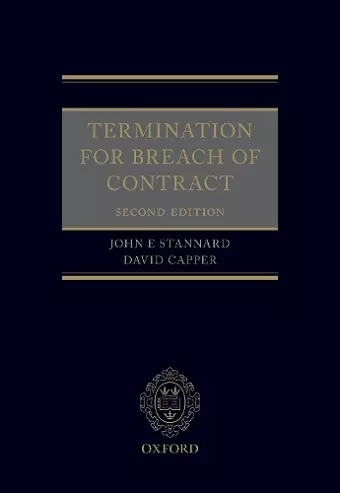Termination for Breach of Contract
John Stannard author David Capper author
Format:Hardback
Publisher:Oxford University Press
Published:12th Nov '20
Currently unavailable, and unfortunately no date known when it will be back

Providing a comprehensive and detailed treatment of termination as a remedy for breach of contract, this book gives a current account of the law and explains this complex area in a practical context. This book is divided into four parts. The first section sets out to analyse what is involved in termination and looks at some of the difficulties surrounding the topic, before going on to explain the evolution of the present law and its main principles. The second section provides a thorough analysis of the two key topics of breach and termination. Breach is defined in terms of a failure, without good excuse, to perform an obligation under the contract, and the various aspects of this definition are explained in the light of the relevant authorities. The chapter on breach of contract has continued to take on board the developing principles of contractual construction, most notably in relation to the interpretation of exemption clauses, where Supreme Court and Court of Appeal decisions, namely Impact Funding Solutions Ltd v Barrington Support Services Ltd and Persimmon Homes Ltd v Ove Arup and Partners Ltd, have continued to question the extent to which the traditional approach can be reconciled with the broader canons of commercial construction now adopted by the courts. In the following chapter, termination is defined in the terms of an election by the promisee, in consequence of a breach by the promisor, to claim discharge from his or her own primary obligations under the contract. This process, which can also be seen as a major contractual remedy in its own right, is distinguished from other processes with which it has a close relationship, most notable the right to withhold performance and discharge under the doctrine of frustration. The controversial decision of the Court of Appeal in MSC Mediterranean Shipping Co SA v Cottonex Anstalt is discussed here. The third part addresses the question when the right to terminate for breach arises. The law gives two answers to this question - when the term broken is classified as a 'condition' of when a 'fundamental' breach has occurred. The nature of a 'condition' in this sense is explained, and the criteria for identifying when a term should be classified as such is set out. Similarly, the...
ISBN: 9780198852292
Dimensions: 254mm x 176mm x 30mm
Weight: 886g
418 pages
2nd Revised edition